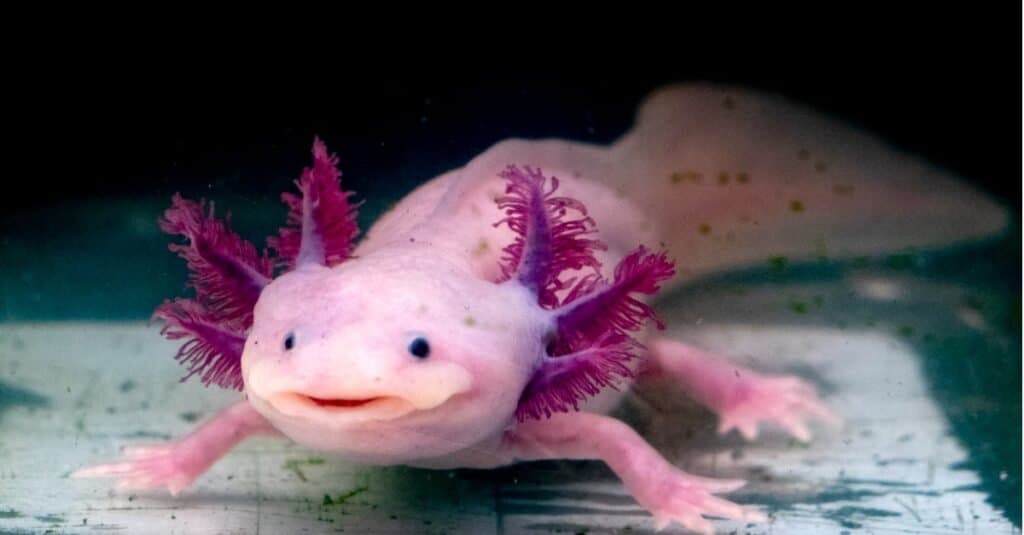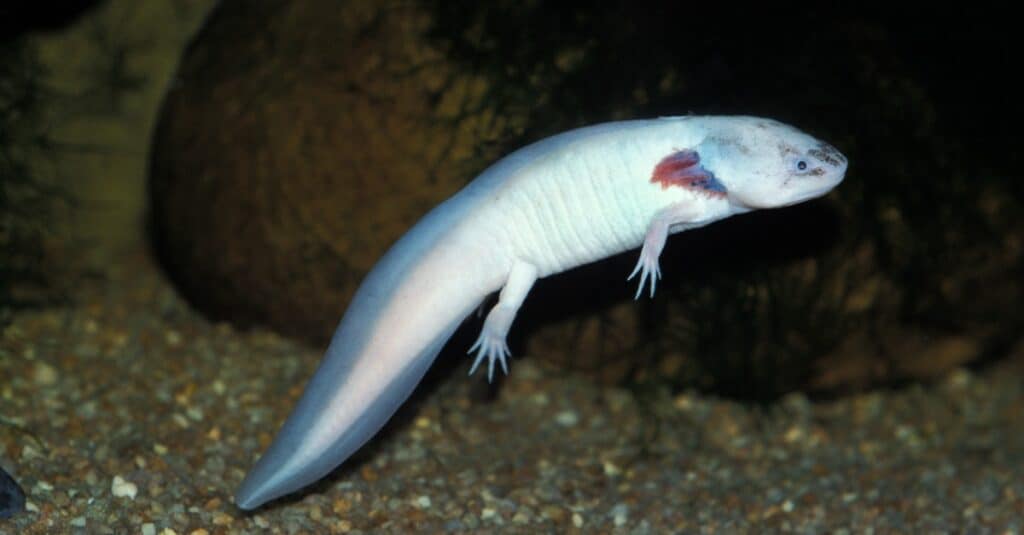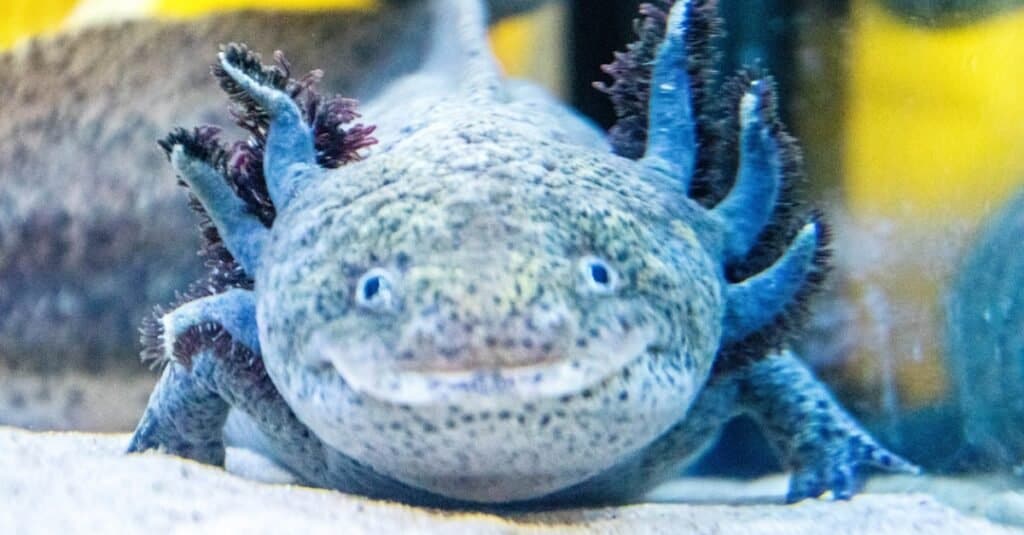Axolotls are unique amphibians related to tiger salamanders. Nearly extinct, breeding axolotls in captivity keeps the species alive and develops colorful new varieties. But do axolotls make good pets? That depends on your experience raising amphibians with uncommon needs.
This particular amphibian is aquatic and spends all its time in the water. Be advised that axolotls require water temperatures below 70 degrees Fahrenheit. Living in higher temps could cause your pet to develop fungal infections and other life-threatening conditions.
That’s just one of several important requirements to keeping a pet axolotl healthy and happy. Keep reading to learn more about the axolotl and whether or not this exciting species of salamander is the right pet for you.
Do Axolotls Make Good Pets?

Axolotls need proper care, as they can be harmed or killed easily.
©iStock.com/izanbar
Axolotls make good pets but are delicate and need lots of attention. It’s very easy to harm or kill them in captivity, so be prepared with a suitable tank setup. Monitor the tank environment every day for proper temperature, cleanliness, and obstacles that could potentially crush them.
Axolotls have very soft bodies and porous skin, making them easy to harm. Because of their soft and delicate structure, it’s best to avoid touching them whenever possible.
The good news about the fragile axolotl is their ability to self-heal. Did you know that when an axolotl loses a limb, they can grow it back? It’s true! Axolotls regenerate their limbs, tail, and some tissues of the brain, eyes, and heart.
It might take months for your pet axolotl to get back on their feet (pun intended), but a lost limb should grow back soon if your pet is otherwise healthy.
What Do Axolotls Look Like?

Mutant axolotls come in different colors.
©iStock.com/slowmotiongli
The main native axolotl species are dark green or brown with dark gray or gold spots. New breeds developed in captivity include the following five varieties:
- Albino – white skin and red eyes
- Golden Albino – golden skin and gold eyes
- Leucistic – pale pink skin and black eyes
- Melanoid – solid black or blue skin and black eyes
- Xanthic – gray skin with black eyes
There are currently ten types of axolotl morphs or mutant varieties, so you’ll have many choices depending on which ones are available in your area.
How big do axolotls get? Adult axolotls range from 6 to 18 inches (15 to 45 cm) and reach maturity between 18 and 27 months.
Axolotls have a condition called neoteny, which means they keep features from their larval stage their entire lives – specifically their external gills and tail fin. They also have a large flat head, wide-set lidless eyes, and a mouth that appears like it’s always smiling.
Where Do Axolotls Come From?

Axolotls are native to Mexico.
©iStock.com/NORRIE3699
Axolotls are originally from Mexico. At one time, the axolotl lived in only two freshwater lakes near Mexico City; Lake Xochimilco and Lake Chalco. However, the need for city flood prevention led to the draining of Lake Chalco and the reduction of Lake Xochimilco to canals only. As a result, the axolotl population in nature is nearly extinct as their numbers grow in captivity.
When axolotls were plentiful in both Mexico City lakes, the temperature of their native waters rarely went above 68 degrees Fahrenheit. For that reason, pet axolotls need to live in temperature-controlled water tanks to keep them healthy.
What Do Pet Axolotls Eat?

The axolotl is aquatic. It must live full-time in temp-controlled water.
©Spok83/Shutterstock.com
The axolotl diet is high in animal protein. Bloodworms, reptile-quality earthworms, and blackworms are common foods axolotls love. Vary their diet when possible with other proteins like brine shrimp, live daphnia (water fleas), or specially-formulated axolotl pellets. Most of these foods should be available frozen (thaw before using) or live at pet stores.
Ensure an axolotls’ food portions are small and don’t get stuck in their GI tract. Axolotls eat by opening their mouths wide and sucking in water. This strong suction could pull in food and other objects too big for their digestive tract to handle. Unfortunately, bowel obstruction is a common killer of axolotls. So keep food portions small and fillers like gravel out of the tank.
There is a chance that an axolotl will munch on any plants growing in its tank because they are attracted to the movement of the leaves. For this reason, it’s essential that plants and faux plants in the tank are non-toxic.
How Do You Setup an Axolotl Tank?
Here are some quick tips for proper axolotl tank setup to ensure their good health and survival:
- For one axolotl, choose a tank size of at least 20 gallons.
- Add 10 gallons to your tank size for each additional axolotl. For example, use a 30-gallon tank for two axolotls. For three axolotls, use a 40-gallon tank.
- Use a low-flow filter to rid the tank of tiny contaminants.
- Keep the water temperature between 60 to 65 degrees Fahrenheit. This might require using an aquarium chiller or keeping the tank in a colder room.
- Do not use gravel in the tank because axolotls will accidentally inhale it.
For more in-depth info about axolotl tank setup and care, check out our articles on axolotls as pets and our pet axolotl guide.
How Long Do Axolotls Live?
The lifespan of an axolotl in captivity is 10-15 years. How long your pet axolotl lives is mainly up to you. Though they’re very fragile amphibians, axolotls are interesting pets to observe for many years if given the best care. Be prepared for their needs and enjoy your unique aquatic companions!
The photo featured at the top of this post is © Meggyn Pomerleau/Shutterstock.com
Thank you for reading! Have some feedback for us? Contact the AZ Animals editorial team.







